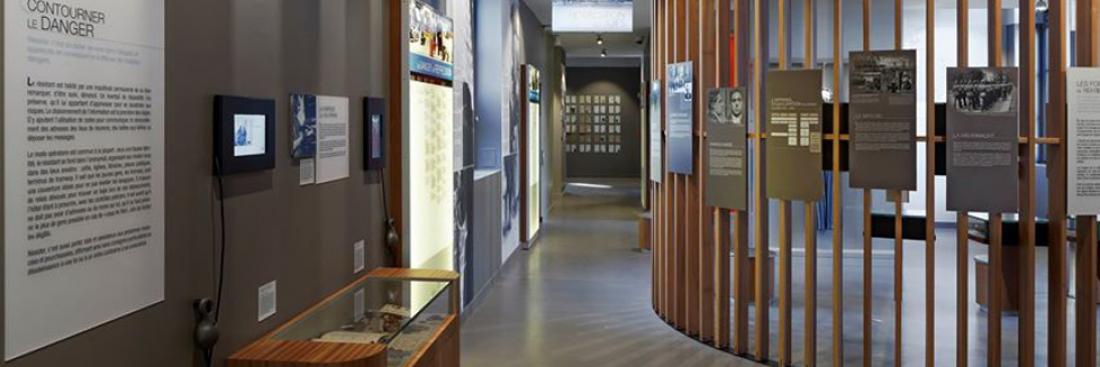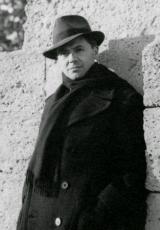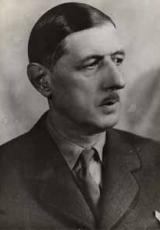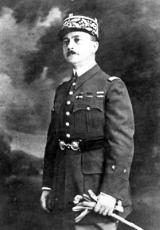In the footsteps of the Resistance in Lyon

Recipient of the Medal of the Resistance with a rosette by decree on 26 November 1946 and the Cross of the Knight of the Legion of Honour with attribution of the War Cross with a palm on 28 February 1949, the City of Lyon is a major centre of the Resistance.
On 19 June 1940, German troops entered the city for the first time.
On 22 June 1940, just nine months after the war was declared, Maréchal Philippe Pétain signed the armistice with Germany. France was divided into two main zones, with the Occupation forces pulling back to the northern zone. Many people refused to admit defeat and were prepared to carry on with the fight. The first Resistance movements were born. Their actions first consisted in distributing tracts and newspapers calling on the French to rise up against the enemy. A wide range of underground newspapers saw the date, such as Combat, Franc-Tireur, Le Coq Enchaîné, Libération, Les Cahiers du Témoignage Chrétien and L'Insurgé. The struggle became increasingly fierce, with an ever-greater effort to hunt down Jewish residents. After the Allied landing in North Africa on 8 November 1942, the Free Zone was invaded by the Wehrmacht.
On 11 November, German troops once again occupied Lyon. The occupation was now complete, and the union of the Resistance movements became a necessity. Jean Moulin created the Conseil National de la Résistance (National Council of the Resistance) and, on 26 January 1943, the Unified Movements of the Resistance was founded in Lyon. That same year also saw the founding of the Maquis to the north and south of the urban area, which took in young people seeking to avoid Compulsory Work Service (S.T.O. - Service du Travail Obligatoire). But with the Allied landings came a series of massacres. The inmates at Montluc Prison were executed en masse at different locations in the Lyon region. The Resistance retaliated and sparked the insurrection of Villeurbanne, but the city was reoccupied two days later. As the First French Army was nearing the city, the Germans blew up the bridges over the Rhône and the Saône. General Brosset's troops didn't liberate the city until 3 September.
You can relive an important period of our History by following these Chemins de Mémoire.
In the footsteps of Jean Moulin (Circuit No. 1)
Rue Jean Moulin, a memorial to Jean Moulin is located in this street, between numbers 1b and 5. He was first appointed prefect in March 1937, and was the youngest prefect in France. In 1939, he was Prefect of the Eure-et-Loir department in Chartres when the German troops entered the city. On 17 June, he refused to sign a document drawn up by the Germans that wrongfully accused the Senegalese troops in the French Army of having committed massacres of the civilian population. He was beaten and locked up and, to escape the threat and dishonour, he preferred to slit his own throat. He barely escaped death and was released. He then heard tell of the formation of the early Resistance in the southern zone. He went to London to request resources for these movements. General de Gaulle assigned him the mission of unifying these different movements and to turn them into a secret army of the Free French Forces completely under his orders. General Delestraint was to become the head. In November 1942, the first meeting of the Coordination Committee was held, later to become the Unified Resistance Movements (Mouvements Unis de la Résistance). General de Gaulle also put him in charge of creating the National Council of the Resistance.
Jean Moulin was arrested at a meeting in Caluire. He was tortured, imprisoned at Montluc and died in Metz as he was being transferred to Germany. He played an important role in the resistance as the liaison between the interior Resistance organisations and those outside France. The home of Doctor Dugoujon. General Delestraint, head of the Secret Army, was arrested on 9 June 1943. A meeting was then scheduled by Jean Moulin for 21 June at Caluire to replace him. But the Gestapo showed up and the participants were arrested, imprisoned at Montluc and deported.
The Ecole de Santé de l'Armée, now the Resistance and Deportation Centre. Here, men and women were tortured, sometimes to death. Others were executed by firing squad in the basement. Jean Moulin was interrogated by Klaus Barbie, head of the Gestapo in Lyon. When Barbie gave him a paper for him to write down names, Moulin drew a caricature of his torturer. On 26 May 1945, the building was partially destroyed by the American aviation, killing Gestapo agents.
Repression and detention (Circuit No. 2)
Montluc Prison (Rue Jeanne Hachette). After the invasion of the southern zone in November 1942, the Germans requisitioned this location to imprison resistance fighters, Jews and hostages. Nearby, they set up a military tribunal, which halted its operations in the spring of 1944 when there was a major turn of events, especially after the Allied landing. But prisoners were soon to be massacred throughout the Lyon region. Most were executed without have been sentenced, with the victims often being chosen at random. There were also many victims killed while in custody or at the Gestapo headquarters. Yves Farge, named High Commissioner of the Republic for the Rhône-Alpes region by de Gaulle in April 1944, managed to get the keys to the prison on 21 August, i.e. twelve days before the liberation of the city, from the German general who held the city's garrison, thus saving, in extremis, 800 hostages from execution. Lyon was liberated on 3 September.
Place Bellecour, Le Veilleur de Pierre (Stone Watchman). During the night of 26 July 1944, resistance fighters carried out an attack on ”Le Moulin à Vent”, a café that was popular with the Gestapo. The next morning, the Germans stopped traffic to kill 5 men who were left lying in the sun for everyone to see, but they were not the ones who had carried out the attack. Without realising it, the Germans had gathered up men of different beliefs, social backgrounds and movements who were all fighting for the same cause, the liberation of their country. Le Veilleur de Pierre is located at the location of the café and stands as a reminder of the different massacres at sites around the region.
Saint-Genis-Laval, Caveau des Martyrs (Tomb of the Martyrs). On 20 August 1944, a few days before the liberation of Lyon, the Germans took 120 prisoners from Montluc and murdered them at the Fort de Côte Lorette, which they burned once the massacre was finished. Some ten Frenchmen gave them a hand. An immense tomb holds the ashes of the victims.
Bron (Avenue Général de Gaulle). On 15 August 1944, the allied bombings caused damage to Bron Airport. 50 prisoners were taken there to do the cleanup work. On their way back to the prison in the evening, they were taken to another worksite where no one had ever worked before and disappeared without a trace. After the Liberation, when the site was cleared, 109 other bodies were found. Villeurbanne, La Doua. Between October 1943 and July 1944, 77 prisoners were judged by the German military tribunal and sentenced to death. They were allowed to meet with a priest and to write a letter to their loved ones before being executed by a firing squad at the La Doua shooting range.
Memory of the Occupation in the Eastern Lyon area (Circuit No. 3)
Villeurbanne, Square de la Déportation. This square commemorates the German roundup of Villeurbanne residents on 1 March 1943 in the neighbourhood of Place Grand-Clément. Deported to the Mauthausen concentration camp, 63 prisoners returned, but 15 of them died within four months of coming home. In Décines, at the roundabout with a pyramid, go toward Moulin d'Armont. The memorial, on the right, pays tribute to four members of the Groupes-Francs de l'Armée Secrète who died at this site. The father and son of the Danvaux family took care of logistics and camouflage, and were housing two resistance fighters. On 24 August 1944, they all went to a weapons cache at Meyzieux to pick up some arms. On their way back, their car hit a roadblock set up by the enemy. Some of them were killed in the accident, but the others were shot by the Germans.
Bron, the new cemetery. A marker honours the agents of the National Transmissions Service - French Fighting Forces at Bron Airport who were arrested by the Germans at the site on 17 July 1944 and died during their deportation.
Vénissieux, Route de Vienne, Renault garage. On 9 August 1944, armed resistance fighters attacked this garage and blew up the lorries and light vehicles. The Germans investigated and came to the site with five men who were immediately shot. Their bodies were removed after several hours. They had not committed the attack, but rather were prisoners at Montluc Prison.
Vénissieux, Place Léon Sublet. Resistance and Deportation Museum. On the façade of this building, there are four bronze bas-reliefs in honour of 94 resistance fighters, most of them foreigners, who were members of Main d'Oeuvre Immigrée (Immigrant Labourers) and belonged to the Liberté battalion.
Saint-Priest, SNCF passenger train station. A plaque on the wall of the platform pays tribute to the agents of the SNCF (the French National Railway Company) who were resistance fighters and were killed during the war. Feyzin, 3, rue du docteur Long. Doctor Long, member of Le Coq Enchaîné, distributed tracts and newspapers, formed sabotage teams, provided military intelligence by spying on factories that produced war material and cared for resistance fighters. But he was taken from his home and found dead at this site with a message from his murderers: ”Terror against terror, this man paid with his life for the death of a national”.
Resistance Fighter Trail (Circuit No. 4)
Corner of Rue Victor-Hugo and Rue Sala. This building is where the ”France d'Abord” movement was founded. It was directed by Jean Cotton and Colonel Schwazfeld, who was in charge of organising the radio service and the military and civilian intelligence service. He was arrested with Jean Moulin and deported. Jean Cotton was the deputy of General Delestraint, whose headquarters were located here.
Place Bellecour and the corner of Rue Saint-Exupéry. Prisoners from Montluc were tortured in this building, which was occupied by the Gestapo and its French accomplices. Some died in the basement after being tortured or were murdered.
Place Bellecour and the corner of Rue De Gasparin. In the night of 26 to 27 July 1944, an explosion hit the café ”Le Moulin à Vent” (the location of this establishment is where the ”Le Veilleur de Pierre” statue stands). The resistance fighters placed their explosives in the café in the evening, before it closed. The café was mainly a meeting place for the Gestapo. The next morning, the Germans had blocked traffic, stopped a car and took out five young men who were immediately shot and left in the sun for 3 hours. They had been imprisoned for several weeks and in no way could have been involved in the bombing.
9, Cours Gambetta. The meeting place and site of the arrest of six leaders of the Forces Unies de la Jeunesse (United Youth Forces), imprisoned at Montluc and executed by firing squad at Gênas.
Corner of Rue Puits-Gaillol and Rue Romarin. Antoine Fontlupt was murdered here. He had organised armed attacks, train explosions and the hijacking of a German mail convoy.
At 12, Rue Ste-Catherine. This site pays tribute to the 80 Jews arrested on 7 February 1943 and deported to extermination camps.
Place Tolozan, a marker pays tribute to Jean Moulin, founder of the National Council of the Resistance, and André Lassagne, member of the Libération movement and General Inspector for the southern zone in June 1943.
At 14, Rue Bouteille, there was a letterbox used for transmitting the Resistance's encoded messages. The Germans finally put it under observation, leading to the arrest of General Delestraint.
Traboules. Resistance fighters used this system of covered passageways between buildings to go from one street to another, where the Gestapo was certain to lose track of them. They were also used as package drop-off points.




